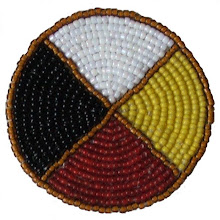Patterson, Mike. 2000. “Confessions of a Webmaster: on Morphing to the Transhuman Era”. Second Comprehensive exam, being in Cultural Studies, also to be interpreted in the realm of Power and Stratification, given toward Ph.D. in Sociology at
…The Moccasin Telegraph today is a continuation of communication and creative expression on the part of Natives. In cyberspace, Native perspectives can become louder and clearer. As mainstream society learns to understand and respect Natives for who they are, they are acting in accordance with the Seventh Fire prophecy.
…First Nations people are travelling in cyberspace along with the mainstream, but again as in the Iroquoian Two-Row Wampum belt of the 1600s, picturing two canoes going parallel down the river, together but not mixing, Natives have to find unique ways to use the technology based on Native values and worldviews.
…Use of cyberspace should benefit the community by promoting awareness of Native values, helping to gain mainstream respect for spiritual practices and prophecies, and through assisting in the cultural, spiritual and political process of self-determination. Throughout this country on reserves and in the cities the people still feel the extreme urgency and concern for cultural survival, for the preservation of languages and teachings.
…The powwow is continuing today in cyberspace. Individuals, Nations and organizations all have their own websites, reflecting their individual culture. At the same time, they have the opportunity to visit other people, and Nations, and learn about theirs.
…We need an MC, and a powwow committee, to help bring this powwow together. The people get lost at mega-sites such as Yahoo; there needs to be a better map to the territory. But just as it took thousands of years to develop the trade routes, territories and alliances among Natives across
…The Aboriginal community on the InterNet is growing fast, and now more Native bands, companies and organizations are using websites to reach their clients, associates and members. People who have moved away from their home communities can feel connected by accessing an online resource from the community. People can access their local news publication on the Net. And they can speak to the world, from home.
…Bears can be the go-between, between the bush and the village, always circling and crossing over where the forest meets the highway. They take messages back and forth between two worlds such as human/spirit (Anishnabe, Onkwehonwe) or human/machine.
…This sharing and distribution is also part of the trend toward distinct and free cybercommunities on the InterNet. First Nations and other users of the Net have at least two out of three of Foucault’s “three great variables,” there being “territory, communication and speed” (1984: 244). It was the technology of the horse that enabled the Plains Indians to become the finest survivors, and light cavalry, of their day and place.
…I don’t believe that access to information on Aboriginal groups of all types will serve to “push groups apart,” the more information Native people can share, the better. Pan-Indianism may be a threat to individual Native identities (i.e. the adoption of the Plains powwow in the East, use of Dream Catcher traditions by non-Ojibwe, use of the Plains drum everywhere), but I believe it has been far more powerful in bringing different Native people together in a sharing of traditions, and issues and concerns. Mohawks did not lose the water drum when they adopted the Plains drum for powwows and other events, Natives do not necessarily lose their traditions by adopting others. Pan-Indianism may appear to be a ‘generic’ Indian style at powwows and gatherings, supplanting local customs, but Natives themselves know the differences between their own (Mohawk, Ojibwe, Hopi etc.) traditions and those that have spread and evolved over the Powwow Trail in the last 20-30 years.
